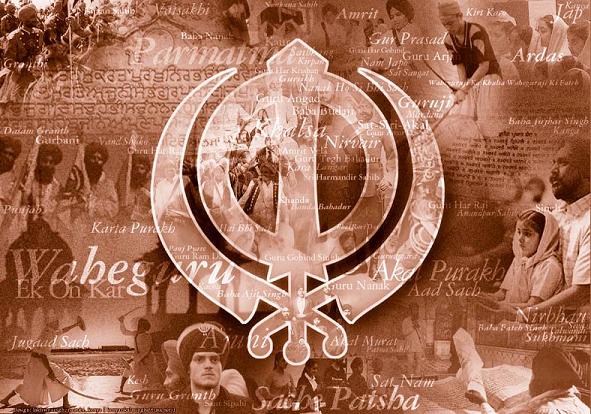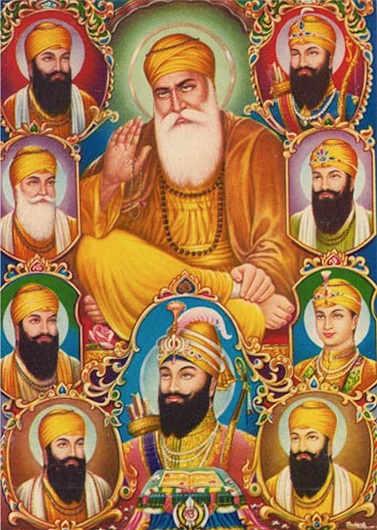Proclamation of Halemi Raj by Guru Arjan Sahib
(Guruship 1581 – 1606)
Halemi = From Arabic word “hilam”, meaning humility.
Raj = Rule; regime; administration; prevalent socio-political environment
This article explores the meaning, significance and context of the proclamation of Halemi Raj in Gurbani and in Gur-Ithhaas (Guru history).
The prompt for this article came from Sikh Youth Australia running their annual Family Camp from 10 January 2024. Halemi Raj is the main theme of the Camp.
In view of that, I have digressed slightly at places to explain certain Sikhi concepts with pointers to further study and discussion. Some repetition under different headings is intentional.
In His Ardas (supplication) in a Shabad (SGGS Ang 74), Guru Arjan adds a certain urgency which comes through in the following Panktis:
ਦੇ ਕੰਨੁ ਸੁਣਹੁ ਅਰਦਾਸਿ ਜੀਉ॥
Turn your ear towards me and hear my prayer, O Lord…...
The Ardas is heard and the Guru is given Divine assurance which He conveys to the humanity:
ਹੁਣਿ ਹੁਕਮੁ ਹੋਆ ਮਿਹਰਵਾਣ ਦਾ॥
Now, the Merciful Lord has issued His Command…………
ਪੈ ਕੋਇ ਨ ਕਿਸੈ ਰਞਾਣਦਾ॥
Let no one attack and inflict suffering on anyone else…….
In His vision, the Guru sees coming of Halemi Raj:
ਸਭ ਸੁਖਾਲੀ ਵੁਠੀਆ ਇਹੁ ਹੋਆ ਹਲੇਮੀ ਰਾਜੁ ਜੀਉ॥
Now all abide in harmonious peace, and this is the regime of co-existence in humility.
This Shabad also reminds us of Guru Nanak Sahib’s Babar Vani.
In Gurbani, the Guru talks directly to the Creator Being. At times, the language reminds one of child-parent relationship. The child complaints about or asks for something. In Babar Vani, Guru Nanak complained about the mass slaughter and cruelty that followed Babar’s invasion of “Hindostan”.
Approach to the Interpretation of Gurbani
The topic of Halemi Raj is central to Sikh ideology and activism. It is the Sikh miri-piri (temporal-spiritual) goal and requires a holistic approach in the mode:
ਇਕਾ ਬਾਣੀ ਇਕੁ ਗੁਰੁ ਇਕੋ ਸਬਦੁ ਵੀਚਾਰਿ॥
There is One Bani; there is One Guru; there is one Shabad to contemplate. (SGGS Ang: 646)
Bani is Guru and Guru is Bani (SGGS 982) .
Despite apparently many authors, there is only one Message of One Guru in Sri Guru Granth Sahib (SGGS). It makes no difference if the author is a Guru-person or a Bhagat given a place of honour in SGGS, because the Same Jot-Jugat (Guiding Light and the way i.e. methodology) pervades the whole Guru period and now resides in SGGS.
ਸਭੁ ਇਕੋ ਸਬਦੁ ਵਰਤਦਾ ਜੋ ਕਰੇ ਸੁ ਹੋਈ ॥
There is only One all-pervasive Shabad and whatever IT Wills/Commands, it comes to pass. (SGGS Ang 654)
Yet, the topic of Halemi Raj needs discussion from different religious, social, economic and political perspectives. Some of these are covered in this article.
Characteristics of Halemi Raj in Sri Guru Granth Sahib
Guru Arjan Sahib (Guruship 1581-1606) proclaims with some urgency that it is now the Divine Command (Hun Hukam hoa) of the Merciful Lord Whom all serve, that the human society shall evolve towards a just and gentle regime. In that regime (such will be the total environment - raj ) that no-one will cause pain or suffering to another and all will live in peace at individual and societal levels.
Here, inner peace of the human mind is as important as external peace. Also, as someone said, absence of war does not mean peace.
Some characteristics of Halemi Raj, envisioned in some detail under Begumpura (city without sorrow) Shabad by Bhagat Ravidas (SGGS Ang 345), are as follows:
There are no societal divisions of caste or class.
There are no worries about taxes or property there.
There is no fear, blemish or downfall there.
There is lasting peace and safety there because those who live there are contented.
There is stable and eternal Kingdom of God there.
There is no competition and all are equal.
All are free to go wherever they please because they know that in the Lord's presence, no one can restrict their movement.
Perhaps there is also a pointer to no property and no need for traditional government.
The above bullet points become relevant when we look at the Sikh institutions evolved over the Guru period (see below).
This is a topic for life-time learning through lived-Sikhi experience. Some introductory clarification of key concepts would help in understanding the Guru’s ideal of Halemi Raj.
Like the prophetic mind, Gurbani is multidimensional while the human mind is capable of linear thought process only. Prophetic revelations encompass all history and events in the past, present and future. Prophetic vision does not always seem coherent in human language. Scholars should have the humility to accept that prophetic thought and expression are untranslatable in linear mode.
According to Prof Arthur J Arberry writing the introduction to his interpretation of the Holy Koran, all truth is simultaneously present within the Prophet’s enraptured soul. The reader of the scriptures must strive to attain the same all-embracing apprehension. The sudden fluctuations of theme and mood will then no longer present such difficulties as have bewildered critics ambitious to measure the ocean of prophetic eloquence with the thimble of pedestrian analysis.
Thus, for the Sikhs, the whole SGGS should be recognised as a single revelation., self-consistent to the highest degree. What Arthur J Arberry says about the Holy Koran can be said about Gurbani: that It is a miracle of speech which it would be blasphemous to attempt to imitate. It is necessary to study the intricate and richly varied rhythms. This very characteristic feature – that inimitable symphony the very sounds of which move people to tears and ecstasy. Translation sounds dull and flat in comparison with the splendidly decorated original.
Ultimately, consciousness is universal. As a philosopher said, it was already there before brains existed, like an all-pervasive ether. The Guru is that Universal Consciousness.
Time and place of Guru Arjan Dev Ji’s Ardas
The period in Guru Ithhas (Guru history), halfway through the person-Guru succession is important. This Shabad, as a Divine Edict added further clarity to the theo-political objective and activism of Guru Nanak’s Sikhi movement, the establishment of Guru Raj envisioned by Guru Nanak:
ਨਾਨਕਿ ਰਾਜੁ ਚਲਾਇਆ ਸਚੁ ਕੋਟੁ ਸਤਾਣੀ ਨੀਵ ਦੈ ॥
Nanak started His kingdom by building the fortress of Truth on the strongest foundations.
[Pointer to the foundation of the kingdom of truth on everlasting egalitarian institutions.]
The Sikhi edifice was being built on the deep foundation laid by Guru Nanak Sahib.
This pre-Guru Hargobind period, (1581-1606), when Guru Arjan proclaimed Halemi Raj, having completed the Sikhi foundational projects and institutions at Amritsar, the Aad Granth, the Sarovar and Darbar Sahib, and the city-state of Amritsar, was not a turning point or “Transformation of Sikhism” as misinterpreted by those like Gokal Chand Narang. The timing was chosen by Guru Arjan to remind the Sikh movement of Guru Nanak’s theo-social and political revolution and final objective. The Guru felt that this was necessary in view of the condition of the human society and the challenges ahead for the Sikhi movement.
Thus, Halemi Raj is a central objective of Sikhi activism. It deals with the state of human affairs and affairs of state (raj), from a Sikhi perspective.
The scene was set for a confrontation between the oppressive Mughal rule and the Panth of Guru Nanak. The Wording of the Command from the Merciful Lord was certain. The time for change from authoritarian rule to people’s self-rule in which all were free from fear, had come. The approaching time for change in human socio-political affairs had also been envisioned by Bhagat Ravidas in his “Begumpura” Shabad in Sri Guru Granth Sahib.
By the time of the Guru Arjan’s martyrdom (1606) Sikh institutions had been well established on firm foundations and the Mughal rulers and their advisors were well informed and aware of these developments. Time was also approaching for the first Guru martyrdom and the next phase in Guru Nanak’s mission leading up to the high point in Sikhi tradition – Vaisakhi 1699 and the emergence of the Khalsa.
Religious, Social, Economic and Administrative conditions of the times
The religious, social, economic and administrative conditions of the times were described by Guru Nanak Sahib in detail in fairly robust language (and even to the beat of the war-drum in Asa-ki-Vaar) which people would understand.
He had toured the known world and studied the pitiful human condition.
Bhai Gurdas recorded in his Vaaran:
ਬਾਬਾ ਦੇਖੇ ਧਿਆਨ ਧਰਿ, ਜਲਤੀ ਸਭਿ ਪ੍ਰਿਥਵੀ ਦਿਸਿ ਆਈ।
In His meditation Baba [Guru Nanak] saw the whole world burning i.e. suffering.
ਚੜਿਆ ਸੋਧਣਿ ਧਰਤਿ ਲੁਕਾਈ।
Guru Nanak started his reformation Mission to create a just society. [Halemi Raj].
Medieval corrupt and lavish life style of the Muslim and Hindu rulers resulted in oppressively high taxes on the poor people. People were left defenceless against cruel invaders who took back India’s wealth and Indian slaves to the Middle-Eastern countries. There is much mention of all this in Gurbani.
The crushing tax burden fell on mainly poor farmers central to the economy. It is no surprise that the jats - to be read as the whole farming community and not as a caste - spear-headed the revolutionary Khalsa movement. Also, as even today, farmers numbered the most.
The farmers’ protest in 2020-21 was led by Sikh ideology and sustained by Langars. The farming community of Panjab forced a Modi u-turn regarding unjust farm laws.
Challenges to followers of the Sikhi Path foreseen by Guru Nanak Sahib
Guru Nanak set out to create a benign regime of love, humility and justice, in which no one inflicted pain on another. It was foreseen by the Guru that the sacrifice demanded for treading the path of God-love and truthful conduct was to accept death while living. That meant complete surrender of ego-centric self.
ਜਉ ਤਉ ਪ੍ਰੇਮ ਖੇਲਣ ਕਾ ਚਾਉ ॥
If you desire to play this game of love with Me,
[= If you love the Guru]
ਸਿਰੁ ਧਰਿ ਤਲੀ ਗਲੀ ਮੇਰੀ ਆਉ ॥
Then step onto My Path with your head in hand.
(SGGS 1412)
Guru Nanak’s Path, Vision and socio-spiritual Mission was known. The Guru Vision of Halemi Raj is the same whether described earlier by Bhagat Ravidas, later by Guru Arjan Sahib or which can be constructed with reference to Gurbani.
The theo-political challenges for followers of the path of Sikhi were clear. For example, when Babar put Guru Nanak in prison for speaking the truth, the latter could have been the first Guru Martyr except that Babar was aware, or became aware later, that for the Muslims too, He was Pir Baba Nanak.
The Sikh institutions gained maturity under the earlier Guru-persons, especially Guru Amardas at Goindwal: These included the system of a nationwide network of Guru Nanak’s Sangats, the establishment of the Manjis and periodical daswandh (tithe) donations to the Guru for central institutions and parchar.
Guru Arjan completed the first part of Guru mission with the completion of the Amritsar Sarovar and the institution of Aad Granth. Including the prosperous Sikh city-state of Amritsar, this was too much for the Mughal Raj. It was a challenge which could not be ignored.
The Guru had already planned ahead and raised a Saint-Soldier son, Hargobind, who would raise "Khalsa Akal Purakh ki Fauj". Guru Hargobind first used the "khalsa" word in the Sikh sense in His Hukamnamas (Commands).
Bhagat Kabir had used the same expression “Khalsa” for those linked to the Creator Being.
Living the final chapter of Guru Nanak’s mission, Guru Gobind Singh also made His theo-political mission clear as a benevolent regime in which the saintly will not be oppressed and the evil will be uprooted.
Sikhi Institutions
Just to name a few institutional developments towards Halemi Raj. There would be others. Each of these should be discussed as building blocks of Halemi Raj.
Some of these institutions are as follows:
- Sangat, Pangat (universal Lanagar)
- Naam, Kirat and Wand shakna.
- Sarbat dha bhalaa
- Miri-Piri whole life approach.
- Gender and caste equality added vast numbers to Sikh civil and military organisation.
[For example, think of the role of Singania in the peoples freedom movement led by the Khalsa.]
- Sewa
- Sangats and Manjis;
- Daswandh: tithe: one tenth of annual produce or earnings for supporting central Sikh sewa initiatives and institutions including Khalsa Akal Purakh ki Fauj.
- Degh, Tegh, Fateh of the Khalsa.
The Cauldron – representing the sharing way of Sikhi life – defended by the Sword of the Khalsa ensuring ultimate Victory of a just way of life, -Halemi Raj? - Sikh Ardaas – A powerful uniting institution. A continual summary, update and reminder of Sikh history.
The institutional tools and the inbuilt processes which allow response to socio-political circumstances and challenges, have ensured the survival of Sikhi movement against all odds. Thus, Sikh-Khalsa movement survived to topple unjust Mughal and colonial regimes.
Some recent examples include, the Indian Farmers’ protests led by Panjabi Sikh farmers – the whole ethos was Sikhi based, free Langars etc. PM Modi, fully conversant with Sikh ideology and history, was forced to retreat.
History also tells us that guided instinctively by the underlying egalitarian Sikh ideology and supported by Sikh institutions, apparently leaderless Sikhs can fight to win wars! (Ref: Confused Ahmed Shah Abdali asking : “Who is their leader? Where do they live? etc – A maddening problem for authoritarian dictators!
Looking ahead
There is much negativity about the state of the Panth today. Yet, I recall a time when there were hardly any Amritdhari Singhs in the villages of Panjab. Malwa had huka-smoking Sikhs and Doaba was no better. Yet, these areas produced Sikhs who were always at the forefront of great Morchas which broke the back of colonial rule.
Appearances can deceive regarding Sikhi spirit because Guru Nanak’s message is simple, universal and touches all hearts. No other saint/bhagat/philosopher provided the above tools for survival and dedication to the just cause/objective of Halemi Raj.
In Sikhi, here and now is as important as hereafter. Only service in this world earns a place of respect in the hereafter. Thus “Wich duniya sev kamayiay, tan dargeh baisan paayiay.” Active life of service must go side by side with Naam meditation.
Halemi Raj is not the Utopia of Western philosophers but a future reality made possible by egalitarian Sikhi ideology and institutions.
The spiritual and societal goals of human life need to converge in the concept of Halemi Raj as a spiritual-temporal objective.
That is the purpose of Miri-Piri whole-life Sikhi living.
According to Gurmat ideology, the concept of Halemi Raj or Begampura fully expresses legitimate Sikh theo-political goal. It has been confirmed by legal experts that the Indian Constitution also gives every Sikh the right to carry out this struggle peacefully at the political level within a democratic structure and to move forward with it for its fulfilment.
© Copyright Gurmukh Singh OBE (UK)
E-mail: sewauk2005@yahoo.co.uk
Please acknowledge quotations from this article
Articles may be published subject to prior approval by the author


